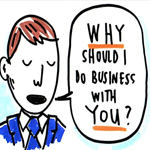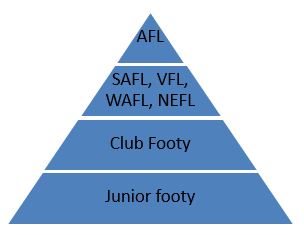 How Marketing & Copywriting Skills are VERY different to Educated Writing Skills.
How Marketing & Copywriting Skills are VERY different to Educated Writing Skills.
One of the joys of sending out a newsletter regularly is the engaged responses you get back from clients and recipients. We had a number of responses to our last newsletter, people asking about Print Town, people congratulating me on my engagement and commenting about my chubby baby (She’s so cute!). But, there was one scribbled letter we received from a Doctor in the mail that criticized us and our newsletter.
“Dear Ben & Zac, I was reading your recent August Newsletter which you sent to me. If you are going to promote yourselves as “experts” who have marketing skills and writing skills then you need to improve the quality of your work. If you want us to trust you and rely on you to write our material you need to do a lot better!!! This page is pathetic!! Spelling errors, errors in grammar, and confusion between nouns and verbs!!!! You need some English lessons!!!! WAIT TILL I SHOW THIS TO COLLEAGUES!!”
This page was accompanied by a violently torn page from our newsletter correcting the grammar and pointing out grammar corrections and where the word ‘practice’ was instead of ‘practise’ with the word JOKE written across the page.
I’ve got to admit, there was a part of me that was offended when I first received this. I mean, we spend our money, and our time putting together and posting out a newsletter for you guys every month… We share our lives, our experiences and our knowledge to help businesses to get more customers and referrals.
But what is really frustrating is that many “highly educated” university qualified business people think that writing marketing the way they wrote their essays in university will get the phone ringing. They are arrogantly oblivious that the biggest barrier to copy-writing success is university level educated writing.
Sandi Krakowski says “If you write me an email, be sure to talk to me in the way we’d chat over coffee or drinks. Whatever you do, don’t put on your “Stuffy Arrogant Business Professional” tone or I’ll hit delete and send you to my blocked lists of email senders.”
People relate to people. So write like a people actually talk.
If you ask any SUCCESSFUL copywriter, they will tell you to use a conversational tone and to write how your market speaks.
Note that I said how your market ‘speaks’ not how they write… even if you are marketing to highly educated people, even though they write ‘stuffy and proper’ they still don’t speak in proper written English.
When you talk there are pauses… there is EMPHASIS on certain words. AND sometimes a sentence DOES start with “but” or “and”… In conversational copy, commas are quick pauses. Full stops are longer pauses… Conversational copy puts people at ease. It’s easy to read… a 12 year old should be able to read ALL of your marketing and comprehend it.
Will it piss off the grammar Nazis… Definitely. But the other 98% of your readers will actually read and engage with what you write.
So to the Adelaide Doctor… While we do appreciate your feedback, we’ll skip the English lessons… We’ll stick to selling with our poor grammar and you can continue to have enough spare time to proof-read and critique our newsletter.
 (My apologies to The Rime Of The Ancient Mariner and Samuel Taylor Coleridge)
(My apologies to The Rime Of The Ancient Mariner and Samuel Taylor Coleridge) I was re-reading an old issue of Dan Kennedy’s NO BS info-marketing letter. And he talked about his over-arching goals of that guided him through his business.
I was re-reading an old issue of Dan Kennedy’s NO BS info-marketing letter. And he talked about his over-arching goals of that guided him through his business. Look, I know this will ruffle some feathers, but there is an important lesson in here and one worth putting up with some discomfort to understand.
Look, I know this will ruffle some feathers, but there is an important lesson in here and one worth putting up with some discomfort to understand. I’ve been racking my brain through my lunch break trying to figure out what to write (this needs to be done today – it’s a big week next week) and what came to me was “What can I do if I need to go and sell some stuff fast?”
I’ve been racking my brain through my lunch break trying to figure out what to write (this needs to be done today – it’s a big week next week) and what came to me was “What can I do if I need to go and sell some stuff fast?” I’ve gone through my past lot of articles for this ezine and realised just how long it has been since I wrote about keeping customers.
I’ve gone through my past lot of articles for this ezine and realised just how long it has been since I wrote about keeping customers. In the first part of this article I talked about how winning and losing needs to be constructed in the context of playing a bigger game to reach your goals. Then having the ability to not take losing (Or winning) personally – which is a major barrier to reaching your goals and success.
In the first part of this article I talked about how winning and losing needs to be constructed in the context of playing a bigger game to reach your goals. Then having the ability to not take losing (Or winning) personally – which is a major barrier to reaching your goals and success. I probably heard the first quote from my mother when I first played under 8’s basketball. I heard the second quote from Mutant League Football on my Sega Megadrive when I was 12.
I probably heard the first quote from my mother when I first played under 8’s basketball. I heard the second quote from Mutant League Football on my Sega Megadrive when I was 12. For most of us that is the hardest question we can answer. It happens to be one of the foundation questions for making a sale.
For most of us that is the hardest question we can answer. It happens to be one of the foundation questions for making a sale. There is a marketing success secret lurking just within our vision – in any professional sporting competition, from cricket to netball to rugby to NRL to AFL.
There is a marketing success secret lurking just within our vision – in any professional sporting competition, from cricket to netball to rugby to NRL to AFL. Then you go down to the level of the seniors at local footy clubs and there are at least 4 times as many again.
Then you go down to the level of the seniors at local footy clubs and there are at least 4 times as many again. The amount your customers spend with you should look like this – few spending a lot, many spending some. A whole lot spending not much. That is a business operating in accordance with nature.
The amount your customers spend with you should look like this – few spending a lot, many spending some. A whole lot spending not much. That is a business operating in accordance with nature.